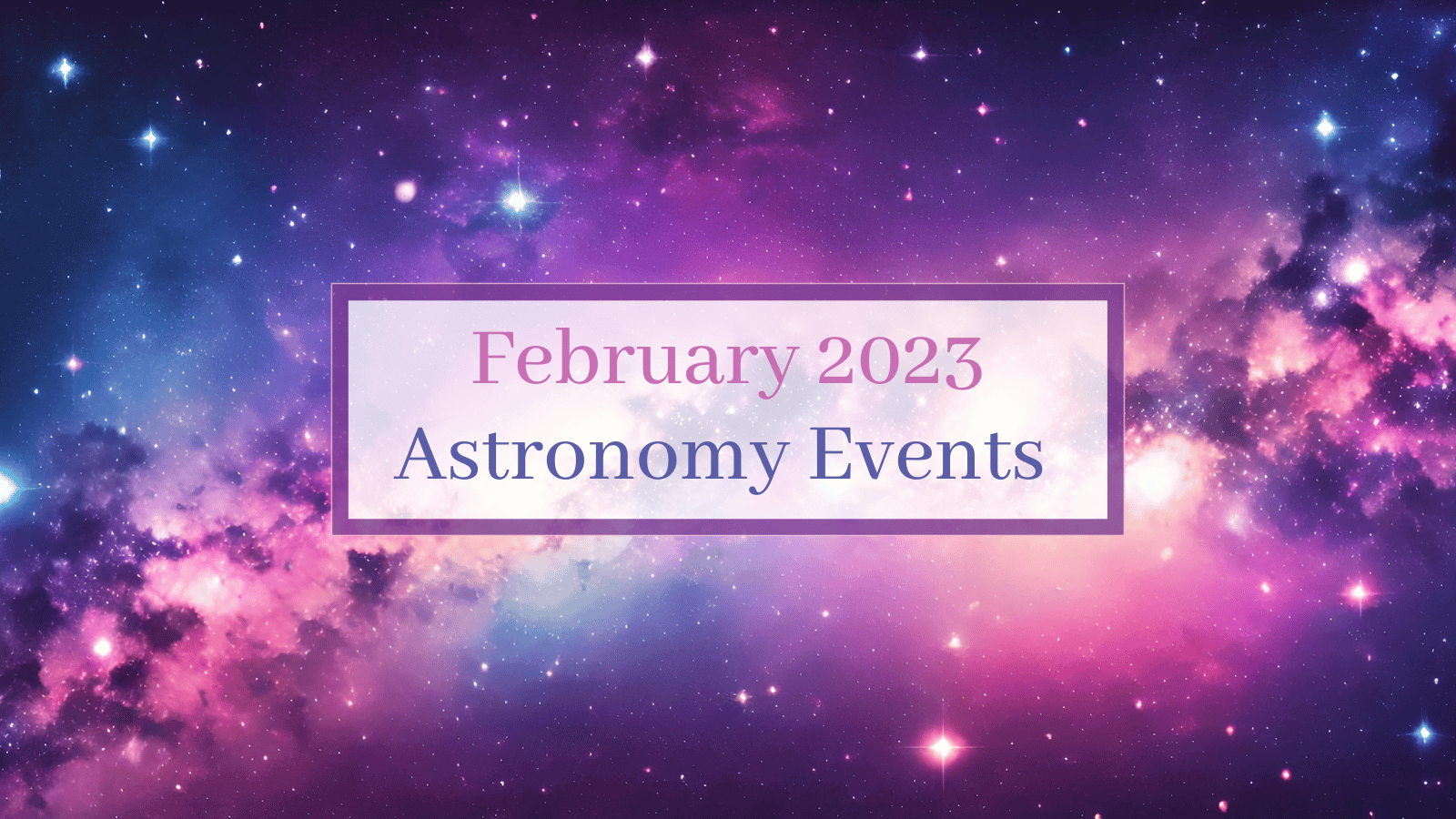The second month of the year brings new celestial alignments and astronomical events for us to observe throughout the night sky. February 2023 kicks off with a rare sighting of the brightest comet of the year and the Full Snow Moon. Then, a few captivating conjunctions take place including Mercury and Pluto as well as Venus and Neptune. The month wraps up with a Super New Moon and lunar occultations of Jupiter and Mars.
(Looking to review last month's astronomy events? View January 2023)
Our highlighted list of astronomy events for the month of February serve as a guide to your stargazing experiences and a reference for the key astronomical events to be aware of.
10 Astronomical Events in February 2023:
- Comet C/2022 E3 (ZTF) at Perigee - 2/1
- Full Snow Moon - 2/5 @ 1:28pm EST
- Mercury and Pluto Conjunction - 2/11 @ 12:03am EST
- 3rd Quarter Moon - 2/13 @ 11:01am EST
- Venus and Neptune Conjunction - 2/15 @ 7:19am EST
- Super New Moon - 2/20 @ 2:06am EST
- Moon and Venus Close Approach - 2/22 @ 4:41am EST
- Lunar Occultation of Jupiter - 2/22 @ 5:57pm EST
- 1st Quarter Moon - 2/27 @ 3:06am EST
- Lunar Occultation of Mars - 2/27 @ 11:11pm EST
For easy article navigation, you can click on a specific event listed above to jump directly to that section. Below, we will explore each of these events in more detail.
Astronomy events to mark on your February 2023 calendar:
February 1st - Comet C/2022 E3 (ZTF) at Perigee

Comet C/2022 E3 (ZTF) will be at perigee, its closest point to Earth, on Wednesday, February 1st. It will be at a distance of 0.28 AU (26.5 million miles / 42.7 million km).
At this time, the comet is expected to reach brightness values as high as magnitude +4.6 positioned in the Camelopardalis constellation.
Using the 48-inch Samuel Oschin robotic telescope, the comet was discovered by astronomers at the Zwicky Transient Facility located in southern California on March 2, 2022.
You might be wondering why this comet is called "C/2022 E3 (ZTF)". The naming convention of comets is based on when they are discovered. "C/2022" represents the comet being discovered in the year 2022. "E3" represents the half-month period it was found in and the number represents the order the comet was found. For example, "A" = first half of January, "B" = second half of January, "C" = first half of February, and so on. Therefore, "E3" signifies this comet being the 3rd comet discovered in the first half of March. Lastly, "ZTF" simply represents the observation detector which in this case was the Zwicky Transient Facility.
However, a comet with a more well established orbit is designated P/ with a number representing the chronological order it was discovered. For example, Comet Halley, being the first to be calculated, is "1P/Halley".
February 5th - Full Moon | Snow Moon

On Sunday, February 5th, the Moon will reach peak illumination during its Full Moon phase of its 29.5 day lunar cycle. The exact moment will occur at 1:28pm EST.
The Moon will be positioned in the Cancer constellation at right ascension 09h21m30s and a declination of 20°37'N. Its angular size will be 29'25".
Whenever the Moon's ecliptic longitude appears 180° away from the Sun's ecliptic longitude, as observed from our perspective on Earth, we experience the Moon's exact moment of full illumination. During this time, the Moon will rise above the horizon around sunset (5:19pm EST on the 5th) and set below the horizon around sunrise (7:45am EST on the 6th).
Although these nights are great for naked-eye views of the Moon, if you are planning to make star cluster or planetary observations the Moon's bright illumination may hinder your sights.
In the Northern Hemisphere, this February Full Moon is referred to as the Snow Moon due to the heavy snow fall during this time. Other names associated with this Full Moon are Hunger Moon and Storm Moon.
February 11th - Mercury and Pluto Conjunction


There will be a Mercury and Pluto conjunction on Friday, February 10. Mercury will pass just 1°34' north of Pluto at 12:03am EST.
Both planets will share the same right ascension 20h06m30s and will be positioned in the Sagittarius constellation. However, Mercury will be at a declination of -21°03' and Pluto will be at a declination of -22°37'.
On this day, Mercury will be shining at magnitude -0.2 and Pluto at magnitude +15.1.
February 13th - 3rd Quarter Moon

The Moon will reach its third quarter phase of its 29.5 day lunar cycle on Monday, February 13th at 11:01am EST. During its last quarter phase, in the Northern Hemisphere, the Moon appears half-illuminated on its western side.
The Moon will be positioned in the Libra constellation at right ascension 15h26m20s and a declination of 20°21'S. Its angular size will be 31'26".
The third quarter moment occurs when the Moon's ecliptic longitude is 90° away from the Sun's ecliptic longitude, from our perspective on Earth. On this day, the Moon will rise above the eastern horizon around 1:00am EST and set at 10:38am EST.
February 15th - Venus and Neptune Conjunction


Venus and Neptune will conjunct on Wednesday, February 15th at 7:19am EST.
Both planets will be positioned in the Aquarius constellation at right ascension 23h38m50s. However, Venus will be at a declination of -03°34' and Neptune will be at a declination of -03°33'.
At this time, Venus will be shining at magnitude -4.0 and Neptune at magnitude +8.0. Their angular sizes will be 11"6 and 2"2 respectively.
February 20th - Super New Moon

We will experience a Super New Moon in the sky on Monday, February 20th at 2:06am EST.
This New Moon is referred to as a Super New Moon because it will be near its closest proximity to the Earth. This is also known as the perigee.
The Moon will be positioned in the Aquarius constellation at right ascension 22h19m00s and at a declination of 15°21'S. Its angular size will be 33'15".
In general, the Moon reaches its New Moon phase once every 29.5 days. At this time, the Moon and the Sun appear to be situated at the same ecliptic longitude.
Although the Moon will be mostly unseen during this phase, the reduced light exposure provides an unusually dark sky. This is a great opportunity for stargazers to observe higher magnitude star clusters and celestial objects that are difficult to view under more illuminated circumstances.
February 22nd - Moon and Venus Close Approach


In the Pisces constellation, the Moon will appear within 1°50' of Venus on February 22nd at 4:41am EST. The Moon will be at a declination of -01°36' and Venus at a declination of +00°01'.
The Moon will be shining at magnitude -9.8 and Venus at magnitude -4.0. Their angular sizes will be 32'35"4 and 11"8 respectively.
This will be a great night to take out the binoculars and catch a glimpse of this beautiful moment.
February 22nd - Lunar Occultation of Jupiter

The Moon will appear to pass in front of Jupiter on Wednesday, February 22nd at 5:57pm EST creating a lunar occultation.
Jupiter will be shining at magnitude -2.1, positioned in the Pisces constellation at right ascension 00h39m10s and a declination of 3°00'N. Its angular size will be 0'33".
February 27th - 1st Quarter Moon

On Monday, February 27th at 3:06am EST the Moon will reach its first quarter phase of its lunar cycle. At this time, in the Northern Hemisphere, the Moon will appear half-illuminated on its eastern side.
The Moon will be positioned in the Taurus constellation at right ascension 04h23m30s and a declination of 24°22'N. Its angular size will be 30'12".
The first quarter moment occurs when the Moon's ecliptic longitude is 90° away from the Sun's ecliptic longitude, from our perspective on Earth. On this day, the Moon will rise above the eastern horizon around 10:14am EST and set at 1:25am EST.
Although many believe that the best time to observe the Moon is at its Full Moon phase, its first quarter phase is generally considered the ideal time for Moon observations. Details of the Moon that are less discernible during a Full Moon are much more pronounced during the first quarter Moon.
February 27th - Lunar Occultation of Mars

The final event we are highlighting for the month of February occurs on Monday, February 27th. The Moon will appear to pass in front of Mars at 11:11pm EST creating a lunar occultation.
Mars will be positioned in the Taurus constellation at right ascension 05h08m50s and a declination of 25°20'N. The planet will be shining at magnitude +0.4 and its angular size will be 0'08".
Start viewing
Now that you have a clear idea of what will be happening in the sky this month, the next step is observation. Some of the events referenced above can be seen without any special optical equipment. However, a quality pair of binoculars or a premium telescope can certainly enhance your viewing experience.
If you're considering purchasing or upgrading your astronomy gear, we have a curated selection of binoculars, telescopes and accessories to choose from. Our online store offers high quality optics from industry-leading brands at value prices to help you explore the world above.
Feel free to browse our telescope collection or browse our binoculars.
If you're unsure where to start you can read through How To Choose The Right Telescope or How To Choose The Right Binoculars for additional guidance.


